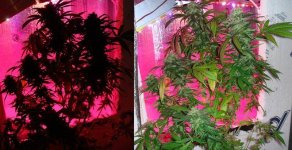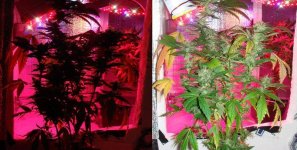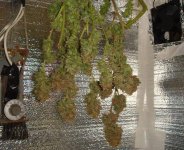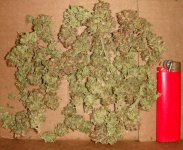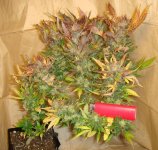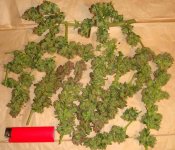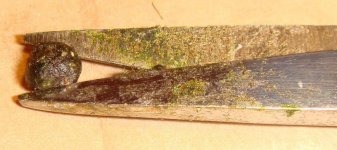Very cool job SupraSPL, ill be watching this thread and diving into the LED world as soon as i can get some LED's from Knna too. He's a very busy man unfortunately. I've basically stopped growing because i want to go LED so bad. Now that i know they exist and can work as well as HPS for a fraction of the electrical bill i can't bring myself to fire up my 400w HPS again 
-
Happy Birthday ICMag! Been 20 years since Gypsy Nirvana created the forum! We are celebrating with a 4/20 Giveaway and by launching a new Patreon tier called "420club". You can read more here.
-
Important notice: ICMag's T.O.U. has been updated. Please review it here. For your convenience, it is also available in the main forum menu, under 'Quick Links"!
You are using an out of date browser. It may not display this or other websites correctly.
You should upgrade or use an alternative browser.
You should upgrade or use an alternative browser.
LED Custom 140
- Thread starter SupraSPL
- Start date
I'm running red string at about ~600 mA and the white/blue string at ~700 mA. This provides ~145 watts for the LEDs to dissipate and consumes ~180 watts. I just eyeballed it for now using the Kill-A-Watt meter but I will get a more accurate measurements of dissipation and current levels as soon as I get a new 10A multimeter.
I would have liked to add some 660nm but as far as I know there are none available on the AlInGaP chips yet which are 2X more efficient.
We use 660nm LED's, and yes they are readily available from many manufacturers (but not Osram since that's what you're using). 660nm is also the most important LED to include in any grow light, as it's directly responsible for the primary flowering response of your plants (640nm is a secondary flowering peak). We use LED's from multiple different companies for this reason specifically, as finding a single company who makes all the nm's you need is literally impossible. As per the AlInGaP red chips, do a little bit of research on Showa Denko of Japan who holds the world record for 660nm output.
So you're using a 3W LED for your light? If so, it would make sense as to why you're pulling 180W when you thought you'd be running 140. To my knowledge, 2W chips don't actually exist, they're just a 3W chip driven between 1W and 3W amperages. Since you mentioned you're running some at 600mA and others at 700mA, it would support the measurement that each LED is not receiving a full 3W (but then again, red 1W LED's don't use a full watt either).
Anyhow, (and I mean no offense as I think it's great you built a functional LED panel yourself) you spent $425 and what seems like 10+ hours building this light, which to my knowledge has no warranty if anything were to go wrong, no casing, no glass to protect the LED's and soldering board from moisture, and no cooling fans. It has limited spectral output due to using only 1 brand of LED's, meaning you're missing half of the spectral diversity necessary to drive photosynthesis properly (absorption peaks at 439nm, 469nm, 642nm, and 667nm) and the 450nm blue you're using misses the 439nm and 469nm peaks all together... Now this doesn't mean your light won't work, it just means that it's not going to be anywhere near as efficient as getting the proper nm's and using all 4 of the photosynthesis peaks (not just 1 red, with a blue that's in between both peaks). It's also a scientific fact that using 3W or 5W LED's vs (3) 1W or (5) 1W LED's, will create over 40% less light. So while 3W LED's are certainly cheap in comparison to 1W's (great for DIY guys), they are about half as efficient when compared to multiple 1W diodes (meaning you need twice as much wattage to create the same amount of light as we do with our units).
Our 126W retails at $475 shipped, comes with a 3 year warranty, has all 4 peak spectral outputs for photosynthesis, Infra-red for cell development, plus white and the extremely intense 60 degree lens (over 4x more intense than the 140 degree Osram lens). Our 126W is also blowing away the 186W Haight Solid State light, which uses the same colors of LED's as used in your light, but that's expected since they also use Osram high wattage LED's which are over 40% less efficient than our 1W's. It just doesn't seem like building your own is as cost effective as some of you like to think... $425 and lots of hours vs $475 with a 3 year warranty and zero hassle, not to mention our light will (and this is proven) outperform yours even though it's less wattage. Never the less, I commend you on taking it upon yourself to build your own, but if you want it done right (at what seems like a very comparable price to building it yourself) trust the pros who do this for a living like us.

Last edited:
SupraSPL
Member
@apollonio THNX! Ya KNNA is very busy at the moment but his work is very promising. I'll be on the lookout for KNNA DIY parts!
@asa77solI really like the Meanwells too. They seem to have every base covered.
@DIYerSo far so good! The LEDs are beating my old HPS setup so far. By how much, I do not know yet but I like what I see.
@LEDGirl I am glad you stopped by to take a look. I am very interested in 660nm on AlInGaP chips and I would have no objection to mixing brands, so I will definitely check out the Japanese manufacturer you mentioned.
The main reason there was confusion on how much power I was drawing was due to lack of a working multimeter. I got a hold of one and tuned and measured the driver's output levels. I am using only half the lamp at the moment, so it is dissipating 71.6 watts through the LEDs and consuming 81 watts input power. The drivers under these conditions are about 88% efficient. The reds are dissipating 1.4 watts each. The whites/blues are dissipating 2.46 watts each. It will be handy to be able to tune the red/blue ratio as needed. I like to add more blue during first few weeks of flowering to reduce stretch in sativas.
You mention "3 watt" vs "1 watt" is a 40% penalty in light. This may be true in absolute terms, but not when you compare apples to apples. (3) 1 watt red LEDs draw more power than (1) 3 watt red LED. The higher current levels I am using would not render the LEDs 40% less efficient. Using the data on your site (2.5v @ 350mA and 2.75v @ 700mA), when I calculate for efficiency, the difference in output is about 17%. This only applies to these particular edison opto LEDs. Other designs may be much closer in output (Cree XP-G R5 for example would be 12%) Also consider, when using a higher bin, the LEDs could be equal or even more efficient than typical "1 watt" LEDs. For example, the bin I am using for blue is a premium bin with 41% radiometric efficiency (@350mA). The edison opto blues on the chart you cited are 26% (@350mA).
As far as wavelength goes, I agree the addition of 660nm would improve efficiency IF it were on AlInGaP chips using top bins. There is every possibility that the inclusion of 660nm on inferior chips could actually reduce the efficiency of my lamp. So I am holding out for the more efficient chips and getting by on 640s. The GD Plus ultra white I am using has its blue peak at 440nm.
The modules were intentionally designed not to use fans which increases the system efficiency (~10%) and reliability. Despite being designed for passive cooling (150cm2 per watt) the heatsinks do end up catching a breeze from my circulation fan, which serves to increase the LEDs output efficiency and of course lumen maintenance. The downside is increased initial heatsink cost and lamp weight (20 lbs for 142 watts dissipation, 5 pounds per module)
As far as infrared, I am not convinced that it could contribute gains that are worth the watts burned, but I admit I still need to research this issue further.
As far as the lenses, from what I understand they reduce overall output by 8-20%. I understand their use in the case of a taller garden, but I always use LST and keep things very short. If I were to grow a taller garden, I would use side lighting rather than attempting to focus the light from the top. A glass panel will further reduce efficiency (~10%). I could use a layer of Kapton over the traces and solder joints if needed. The downside is that I will have to be careful not to foul up the LED's dome. I don't normally water/feed in the chamber and I am very aware of the fragility.
In further explanation of the $$ spent on this lamp, there are other advantages as well (in my case at least). The ability to add and remove modules as needed saves power. Individual modules also allow for adjustable height to accommodate various types and stages of each plant. So with dissipation set at 142 watts it puts my final cost at $3 per watt of dissipation + time.
With all that said, I always highly recommend your lamps to non-DIY people because yours is the best design on the market in my opinion, and also at a fair price.
@asa77solI really like the Meanwells too. They seem to have every base covered.
@DIYerSo far so good! The LEDs are beating my old HPS setup so far. By how much, I do not know yet but I like what I see.
@LEDGirl I am glad you stopped by to take a look. I am very interested in 660nm on AlInGaP chips and I would have no objection to mixing brands, so I will definitely check out the Japanese manufacturer you mentioned.
The main reason there was confusion on how much power I was drawing was due to lack of a working multimeter. I got a hold of one and tuned and measured the driver's output levels. I am using only half the lamp at the moment, so it is dissipating 71.6 watts through the LEDs and consuming 81 watts input power. The drivers under these conditions are about 88% efficient. The reds are dissipating 1.4 watts each. The whites/blues are dissipating 2.46 watts each. It will be handy to be able to tune the red/blue ratio as needed. I like to add more blue during first few weeks of flowering to reduce stretch in sativas.
You mention "3 watt" vs "1 watt" is a 40% penalty in light. This may be true in absolute terms, but not when you compare apples to apples. (3) 1 watt red LEDs draw more power than (1) 3 watt red LED. The higher current levels I am using would not render the LEDs 40% less efficient. Using the data on your site (2.5v @ 350mA and 2.75v @ 700mA), when I calculate for efficiency, the difference in output is about 17%. This only applies to these particular edison opto LEDs. Other designs may be much closer in output (Cree XP-G R5 for example would be 12%) Also consider, when using a higher bin, the LEDs could be equal or even more efficient than typical "1 watt" LEDs. For example, the bin I am using for blue is a premium bin with 41% radiometric efficiency (@350mA). The edison opto blues on the chart you cited are 26% (@350mA).
As far as wavelength goes, I agree the addition of 660nm would improve efficiency IF it were on AlInGaP chips using top bins. There is every possibility that the inclusion of 660nm on inferior chips could actually reduce the efficiency of my lamp. So I am holding out for the more efficient chips and getting by on 640s. The GD Plus ultra white I am using has its blue peak at 440nm.
The modules were intentionally designed not to use fans which increases the system efficiency (~10%) and reliability. Despite being designed for passive cooling (150cm2 per watt) the heatsinks do end up catching a breeze from my circulation fan, which serves to increase the LEDs output efficiency and of course lumen maintenance. The downside is increased initial heatsink cost and lamp weight (20 lbs for 142 watts dissipation, 5 pounds per module)
As far as infrared, I am not convinced that it could contribute gains that are worth the watts burned, but I admit I still need to research this issue further.
As far as the lenses, from what I understand they reduce overall output by 8-20%. I understand their use in the case of a taller garden, but I always use LST and keep things very short. If I were to grow a taller garden, I would use side lighting rather than attempting to focus the light from the top. A glass panel will further reduce efficiency (~10%). I could use a layer of Kapton over the traces and solder joints if needed. The downside is that I will have to be careful not to foul up the LED's dome. I don't normally water/feed in the chamber and I am very aware of the fragility.
In further explanation of the $$ spent on this lamp, there are other advantages as well (in my case at least). The ability to add and remove modules as needed saves power. Individual modules also allow for adjustable height to accommodate various types and stages of each plant. So with dissipation set at 142 watts it puts my final cost at $3 per watt of dissipation + time.
With all that said, I always highly recommend your lamps to non-DIY people because yours is the best design on the market in my opinion, and also at a fair price.
looking good
love the custom job
love the custom job
Thanks Mountain Monkey, glad to see more people considering LED to save watts. Supplementary lighting is a great idea. I wonder if you could use a flat aluminum scrap panel without fins and just spread the LEDs out quite a bit?
Indeed you can. (mmmm kapton...)
I was running 6x 5W LEDEngin star mounted emitters on 18" of 1 x 1/2 x 1/8" 6063 aluminum u-channel extrusions, about $2 worth. At 1.2A they ran for couple months (1.5A with 1.5A fuses before I threw some higher Vf blues in with the reds), with a 10W dale heatsink resistor bolted to the middle of the 6" remainder of the 24" bar, with no issues before i replaced them with these...
24", 3 extrusions ($6), 12 emitters in two strings at 2" spacing, half 660nm red and half cool white, LEDs dissipating 43W per bar (with two resistors burning maybe 12W someplace else). They're functionally done; I need to machine the endplate hardware. Even though the surface area vs volume math works out to be less efficient for 3 extrusions vs one, there seems to be some definite benefits about the orientation of the faces, because the middle extrusion the LEDs are mounted to are cooler than the two extrusions bolted to the sides, with no thermal grease where the extrusions mate. Shrug.
Eventually I want to do thin PCB with integrated boost drivers stuck in between the emitters, so they work off of 12VDC.
They pass the spit test (~100C) easily:






Yeah looking into 5W emitters is bad, I cant help it tho =\
However if you get a chance, look directly into them with welding goggles. It's gorgeous!
Those are not difficult or expensive to build, you just need a hand drill and some taps (dining room CNC machines are neat tho, everything fits all nice). And the bars are convenient to place around the plants.
I am going to try the same density with 12 660nm red (I didn't realize i had so many extra!) without the side extrusions to see if its sane. Probably not...
However the thermal resistance calculations are not hard to do, and if you can get decent heatsink extrusions (these are worst case and they're doing okay!), you can prob run more than 2x the density of these bars.
Also don't flame about the resistors, efficiency isn't priority to me at all right now (as Supra has demonstrated, that part is not a problem if efficiency is an issue).
Also those are really nice resistors. Vishay/Dale 10W 1%, respec'.
SupraSPL
Member
@yesum The plants got a bit taller than I intended. Not including the height of the pot, the canopy is 15"-18". The buds on the bottom are significantly smaller of course. I'm thinking 12"-15" would be a better compromise (makes for easier trimming). This will vary by strain but once the grower settles on a particular strain or two, they will know when to flip to 12/12 to get the perfect finishing height.
@medmaker420 THNX BTW do you have a direct link to your killa gorilla? Sounds like an interesting strain.
BTW do you have a direct link to your killa gorilla? Sounds like an interesting strain.
@ Renz Thanks for sharing your design with us! Considering how much you know about electronics, I assume you already know most of the following info, but for those that do not I will highlight the differences in approach. As you say the LEDs passed the "spit" test. This had me LMBO! It is hilarious but anyway lets get down to design principles. LEDs that are running that hot will suffer severely in terms of output (at least 15%) and lumen maintenance (another 15%). For some design criteria this may not be a factor, but when trying to compete against the likes of a 600w dual spectrum HPS, we need to be top notch in every way.
Another area of consideration is the use of 660nm LEDs. Of course we already beat that horse on this thread, but they are only manufactured on chips achieving 17% radiometric efficiency @ 1A (assuming proper cooling), but that is hopefully soon to change. When I see these available with 30% or better conversion efficiency, I will highly recommend them.
The third consideration is running them at 1.2A-1.5A. We suffer a stiff efficiency penalty here (7% loss when compared to 1A) that will hurt our chances of outgunning the 600w HPS. In my mind the main reason to run 5 watters is to save initial investment $$ by using less LEDs. That savings would be erased by the lower efficiency and lifespan caused by inadequate cooling and high current levels. With all that said, I hope you did not pass judgment on LED's performance based on that experiment. As you probably already realize, there is so much room for improvement
@intel2000 THNX things are looking very good so far. As a VERY rough guess I am seeing 1.25-1.5 gr/watt potential. I have some pix I will get up soon. They aren't very helpful pics though because the fan leaves are hiding most of the bud, so not very impressive looking yet.
@medmaker420 THNX
@ Renz Thanks for sharing your design with us! Considering how much you know about electronics, I assume you already know most of the following info, but for those that do not I will highlight the differences in approach. As you say the LEDs passed the "spit" test. This had me LMBO! It is hilarious but anyway lets get down to design principles. LEDs that are running that hot will suffer severely in terms of output (at least 15%) and lumen maintenance (another 15%). For some design criteria this may not be a factor, but when trying to compete against the likes of a 600w dual spectrum HPS, we need to be top notch in every way.
Another area of consideration is the use of 660nm LEDs. Of course we already beat that horse on this thread, but they are only manufactured on chips achieving 17% radiometric efficiency @ 1A (assuming proper cooling), but that is hopefully soon to change. When I see these available with 30% or better conversion efficiency, I will highly recommend them.
The third consideration is running them at 1.2A-1.5A. We suffer a stiff efficiency penalty here (7% loss when compared to 1A) that will hurt our chances of outgunning the 600w HPS. In my mind the main reason to run 5 watters is to save initial investment $$ by using less LEDs. That savings would be erased by the lower efficiency and lifespan caused by inadequate cooling and high current levels. With all that said, I hope you did not pass judgment on LED's performance based on that experiment. As you probably already realize, there is so much room for improvement
@intel2000 THNX things are looking very good so far. As a VERY rough guess I am seeing 1.25-1.5 gr/watt potential. I have some pix I will get up soon. They aren't very helpful pics though because the fan leaves are hiding most of the bud, so not very impressive looking yet.
@SupraPL. Nice work BTW. Just a little FYI, there is a case to be made for deep red as there is a synergistic effect on plants at 680nm and 700nm called The Emerson Enhancement Effect where essentially the sum is greater than the parts. A 660nm LED does not have enough power at 680nm (LEDs have a spectral width of sometimes up to 35nm so they can spread wider then their primary wavelength) but a white LED will give you some. It might be worthwhile to experiment even though most of the spectrum will not be utilized.
SupraSPL
Member
Hi DrLight. That is interesting I will have to do some more reading on the Emerson Effect. From what I understand, the peak output will shift to a longer wavelength once the LED comes to operating temp. So I assume 660nm LEDs will peak a bit higher in practice. Once they are released on more efficient chips I will certainly experiment with them and try to improve yields even more.
SupraSPL
Member
Thanks Hazy, it has been fun, kinda makes me want to do some more.
Finally got some new pix. The canopies in the photos are about 18" tall. Up to this point, each plant has been getting about 14watts of LED dissipation. Now there are only four ladies and they are sharing 71 watts dissipation, so each plants will be finishing up under ~18 watts.
The first one is Qleaner. It wasn't under the LED for the entire flowering period so I won't judge the grams/watt.
The second is another Qleaner that has been blooming under the LED almost the entire time (2 weeks HPS, 5-6 weeks LED so far). This is the first run with her tho so I have nothing to compare it too. I think it is just about done fattening up but I will let it go awhile and make certain.
The third is a G13 labs Durban Poison that has been under the LED the entire time (5-6 weeks). It is still fattening up. Strangely, the aroma coming from the buds is different under LED than it was under HPS. The aroma seems sweeter now as opposed to hashy/spicy under HPS.
Finally got some new pix. The canopies in the photos are about 18" tall. Up to this point, each plant has been getting about 14watts of LED dissipation. Now there are only four ladies and they are sharing 71 watts dissipation, so each plants will be finishing up under ~18 watts.
The first one is Qleaner. It wasn't under the LED for the entire flowering period so I won't judge the grams/watt.
The second is another Qleaner that has been blooming under the LED almost the entire time (2 weeks HPS, 5-6 weeks LED so far). This is the first run with her tho so I have nothing to compare it too. I think it is just about done fattening up but I will let it go awhile and make certain.
The third is a G13 labs Durban Poison that has been under the LED the entire time (5-6 weeks). It is still fattening up. Strangely, the aroma coming from the buds is different under LED than it was under HPS. The aroma seems sweeter now as opposed to hashy/spicy under HPS.
Attachments
The aroma seems sweeter now as opposed to hashy/spicy under HPS.
Weird! I wonder what would explain that?
Roortokeage
Member
Thanks Hazy, it has been fun, kinda makes me want to do some more.
Finally got some new pix. The canopies in the photos are about 18" tall. Up to this point, each plant has been getting about 14watts of LED dissipation. Now there are only four ladies and they are sharing 71 watts dissipation, so each plants will be finishing up under ~18 watts.
The first one is Qleaner. It wasn't under the LED for the entire flowering period so I won't judge the grams/watt.
The second is another Qleaner that has been blooming under the LED almost the entire time (2 weeks HPS, 5-6 weeks LED so far). This is the first run with her tho so I have nothing to compare it too. I think it is just about done fattening up but I will let it go awhile and make certain.
The third is a G13 labs Durban Poison that has been under the LED the entire time (5-6 weeks). It is still fattening up. Strangely, the aroma coming from the buds is different under LED than it was under HPS. The aroma seems sweeter now as opposed to hashy/spicy under HPS.
Looks good to me man, Wish You could show us how to make one of these things and teh real price. Compared to what Companies try to rape us for.

Hi DrLight. That is interesting I will have to do some more reading on the Emerson Effect. From what I understand, the peak output will shift to a longer wavelength once the LED comes to operating temp. So I assume 660nm LEDs will peak a bit higher in practice. Once they are released on more efficient chips I will certainly experiment with them and try to improve yields even more.
The peak wavelength of an LED is at the operating temp. You will also see on the datasheet the spectral width which is typically about 20nm. So a 660nm LED will vary from 650nm to 670nm but there will be very little power at the edges of the spectra. Bottom line is that a 660nm LED will not have the benefit of the Emerson Effect.
SupraSPL
Member
I did some quick reading on the second Emerson Effect and what I get from it is that (in algae) photosynthesis benefits from the synergy between 660nm + 700nm far red. I didn't find any solid sources that show this effect is the same in higher plants as in algae but I would need to dig deeper.
Another practical concern here is that I am unaware of any highly efficient far red LEDs either in 660nm or 700nm. I think the 660s are on the way soon though.
Still another concern is the difficulty getting an even spread on all the different colors of LED to each leaf.
So unless we can get ahold of high efficiency, high output 660s and 700s (40% radiometric efficiency or better) I expect better yields with the 640s.
Another practical concern here is that I am unaware of any highly efficient far red LEDs either in 660nm or 700nm. I think the 660s are on the way soon though.
Still another concern is the difficulty getting an even spread on all the different colors of LED to each leaf.
So unless we can get ahold of high efficiency, high output 660s and 700s (40% radiometric efficiency or better) I expect better yields with the 640s.
SupraSPL
Member
Finally got some yield numbers and pics to share. Total LED dissipation was 70 watts. 4 plants, each received 17.5 watts. The plants were trimmed aggressively, dried and cured to about 60% relative humidity before being weighed. Here are the best 2 results so far:
Durban Poison G13 labs fem
12.2 grams in 7 weeks
.8 grams/watt/8 weeks
(first two pics)
Qleaner from TGA seeds
16 grams in 8 weeks
.91 grams/watt/8 weeks
(second two pix, dried and stems removed of course)
The bud quality is top notch, frosted nicely and potency verified by veteran smokers. Smell is amazing. The Qleaner is pine/skumk/onion? and grapey-lemon especially when trichs disturbed. The DP is sweet and skunky, very pungent.
There is another Qleaner but it was only partially harvested and the smaller buds were left on to see if they will fatten up. That one is the most promising and yielded the highest but it also seems to have lower quality as far as trichomes go. Hard to say for sure without a smoke test on this one though.
Durban Poison G13 labs fem
12.2 grams in 7 weeks
.8 grams/watt/8 weeks
(first two pics)
Qleaner from TGA seeds
16 grams in 8 weeks
.91 grams/watt/8 weeks
(second two pix, dried and stems removed of course)
The bud quality is top notch, frosted nicely and potency verified by veteran smokers. Smell is amazing. The Qleaner is pine/skumk/onion? and grapey-lemon especially when trichs disturbed. The DP is sweet and skunky, very pungent.
There is another Qleaner but it was only partially harvested and the smaller buds were left on to see if they will fatten up. That one is the most promising and yielded the highest but it also seems to have lower quality as far as trichomes go. Hard to say for sure without a smoke test on this one though.
Attachments
Looks good to me man, Wish You could show us how to make one of these things and teh real price. Compared to what Companies try to rape us for.
That's funny considering he paid about the same amount to build his panels without our casings, heatsinks, etc... as the price we sell our fully functioning units right out of the box including shipping He also doesn't have our spectral output either, which is vital in the world of LED's. His REAL price was literally our retail price, so in my opinion he's the one getting raped by the LED manufacturers selling their products so damn high, not you guys getting "raped" by companies like us who did all the real work like figuring out the correct ratios and nm's to use in our lights. If you think we're screwing you, good luck building our panel any cheaper on your own
So if you want to be DIY guy, hey more power to ya! But realistically you get more from a company like us selling our lights at retail, with FAR less hassle, not to mention a FULL 3 YEAR WARRANTY.
On a side note, Nice job Supra!


